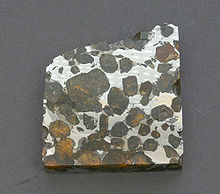Pallasite: Difference between revisions
Ohnoitsjamie (talk | contribs) rv commercial link |
Mannheim 34 (talk | contribs) →External links: Removed link to Commercial website. Please review Wikipedia's rules against spamming |
||
| Line 38: | Line 38: | ||
== External links == |
== External links == |
||
* [http://www.int.iol.co.za/index.php?set_id=1&click_id=31&art_id=qw1161068941938B225 (AP) "Unusual meteorite found in wheat field"] October 17 2006 |
* [http://www.int.iol.co.za/index.php?set_id=1&click_id=31&art_id=qw1161068941938B225 (AP) "Unusual meteorite found in wheat field"] October 17 2006 |
||
*[http://www.aerolite.org/science/glorieta.htm Legend of Glorieta Mountain] Discovery of a large pallasite in New Mexico |
|||
[[Category:Meteorite types]] |
[[Category:Meteorite types]] |
||
Revision as of 16:33, 18 March 2009

A pallasite is a type of stony-iron meteorite. It consists of cm-sized olivine crystals of peridot quality in an iron-nickel matrix. Coarser metal areas develop Widmanstätten patterns upon etching. Minor constituents are schreibersite, troilite and phosphates. Pallasites were once thought to originate at the core-mantle boundary of differentiated asteroids that were subsequently shattered through impacts. An alternative recent hypothesis is that they are impact-generated mixtures of core and mantle materials.[1] They are named for the German naturalist Peter Pallas (1741-1811), who located in 1772 a specimen near Krasnojarsk in the mountains of Siberia that had a mass of 680 kg[2]. The Krasnojarsk mass described by Pallas in 1776 was one of the examples used by E.F.F. Chladni in the 1790s to demonstrate the reality of meteorite falls on the Earth, which were at his time considered by most scientists as fairytales. This rock mass was dissimilar to all rocks or ores found in this area (and the large piece could not have been accidentally transported to the find site), but its content of native metal was similar to other finds known from completely different areas [3]
Pallasite falls
Pallasites are a rare type of meteorites. Only 61 are known to date, including 10 from Antarctica, and only 4 are observed falls [4] [5]. These falls are in chronological order:
Mineo, Sicily, Italy. A luminous meteor was observed and an object seen to fall with a loud roar in May 1826. Only 46g are preserved in collections.
Zaisho, Japan. 330 g were found on February 1st, 1898, after appearance of a fireball.
Marjalahti, Karelia, Russia. After the appearance of a bright meteor and detonations, a large mass was seen to fall and 45 kg were recovered in June 1902. At this date the fall site belonged to Finland, and the main mass of Marjalahti is now at the Geological Museum of the University of Helsinki.
Omolon, Magadan Region, Russia. A reindeer-breeder observed the fall on May 16, 1981 and found the 250 kg meteorite two years later. The fall was confirmed by a meteorological station that had observed a fireball on the same date.
Pallasite finds (most relevants)
Although pallasites are a rare meteorite type, enough pallasite material is found in museums and meteorite collections and is available for research. This is due to large finds, some of which yielded more than a metric ton. The following are the largest finds:
Brenham, Kansas, USA. In 1890 the find of about 20 masses with a total weight of 1000 kg around the shallow Haviland Crater were reported. More masses were found later, including one of 1,000 pounds (454 kg) from a depth of 5 ft, the total amounting to about 4.3 t. A piece of 487 kg is in the Field Museum of Natural History, Chicago. In 2005, Steve Arnold of Arkansas, USA, and Phil Mani of Texas, USA, unearthed a large mass of 650 kg and in 2006 several new large masses [6][7]
Huckitta, Northern Territory, Australia. A mass of 1400 kg was found in 1937, a transported piece of about 1 kg was already found in 1924 at Alice Springs.
Fukang, Xinjiang Province, China. A mass of 1003 kg was recovered in 2000.
Imilac, Atacama Desert, Chile; known since 1822. Numerous masses up to 200 kg were found, the total weight is about 920 kg.
Brahin, Gomel Region, Belarus, known since 1810. Many masses were found in a strewnfield, with a total weight of about 820 kg. An additional mass of 227 kg was found at a depth of 10 ft in 2002.
Esquel, Chubut, Argentina. A large mass of 755 kg was found embedded in soil before 1951.
Krasnojarsk, Yeniseisk, Russia. A mass of about 700 kg was detected in 1749 about 145 miles south of Krasnojarsk. It was seen by P.S. Pallas in 1772 and transported to Krasnojarsk (see above) The main mass of 515 kg is now in Moscow at the Academy of Sciences. Interestingly, a pallasite of 198 kg was found in 1990 near the town Pallasovka, which was named in honour of P.S. Pallas, who studied the geography of this area during his travels in the 18th century.
Fiction
The kryptonite specimen Lex Luthor stole from the Metropolis Natural History Museum in the movie Superman Returns was labeled as a pallasite. Pallasites contain olivine crystals, which have a similar appearance to the green kryptonite crystals from the movie.
References
- ^ Edward R.D. Scott, "Impact Origins for Pallasites," Lunar and Planetary Science XXXVIII, 2007.
- ^ P.S.Pallas, Reise durch die verschiedenen Provinzen des russischen Reichs. St.Petersburg 1776
- ^ E.F.F.Chladni, Observation on a mass of iron found in Siberia by Professor Pallas, and other masses of the like kind, with some conjectures respecting their connection with certain natural phenomena. Philosophical Magazine and Journal of Science, 1798, vol.2, 1-8.
- ^ Meteoritical Bulletin Database
- ^ MetBase
- ^ Mammoth meteorite unearthed, January 2006 about the October 2005 find
- ^ CNN: Unusual meteorite found in Kansas, October 16, 2006.
External links
- (AP) "Unusual meteorite found in wheat field" October 17 2006
